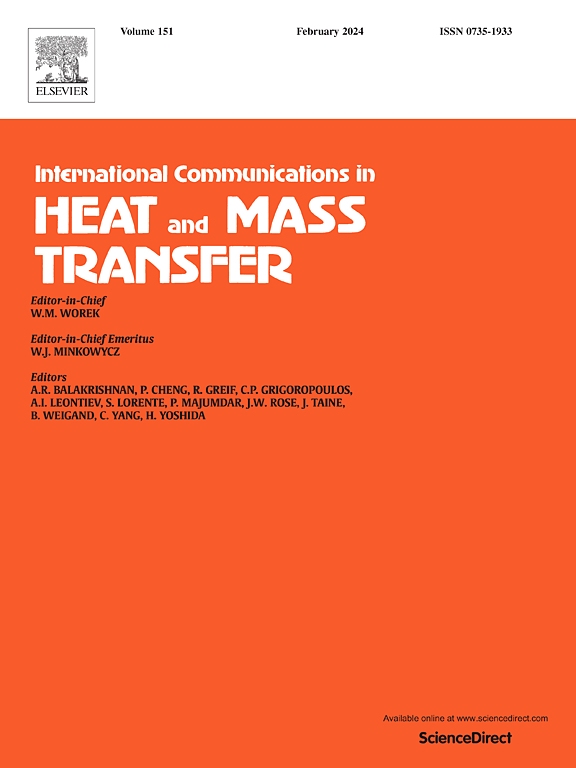Numerical investigation of thermal energy storage characteristics of dual phase change material in double elliptic pipe
IF 6.4
2区 工程技术
Q1 MECHANICS
International Communications in Heat and Mass Transfer
Pub Date : 2025-04-01
DOI:10.1016/j.icheatmasstransfer.2025.108921
引用次数: 0
Abstract
Latent heat storage offers high thermal energy density. However, the low storage rate is a challenge to address. This study aims to evaluate the effects of cascading dual-phase change material (dual-PCM) within a double elliptic pipe on thermal performance and storage rates. The melting process of dual-PCM in the enclosure is numerically analyzed. The numerical model is validated by comparison with experimental data of the literature. Nine design configurations are examined, focusing on the orientation (vertical and horizontal) and the inclination of the elliptic enclosure in order to find out the most effective storage unit. The thermal and flow fields are analyzed alongside the evolution of the melt fraction, charging times, and stored energy. Results indicate that the cascading dual-PCM inside an outer horizontal elliptic enclosure with an inner vertical heating elliptic pipe reduce thermal energy storage time by up to 49 %, demonstrating the most efficient melting process. Furthermore, the study indicates that vertical elliptical pipes reduce thermal energy storage time by 24.7 % compared to horizontal ones, and that lower inclination angles provided a faster and more uniform melting process. Dual-PCM configurations in horizontal orientations significantly enhance energy storage efficiency.
双相变材料在双椭圆管内储热特性的数值研究
潜热储存提供高热能密度。然而,低存储速率是一个需要解决的挑战。本研究旨在评估双相变材料级联在双椭圆管内对热学性能和存储速率的影响。数值分析了双pcm在熔体中的熔化过程。通过与文献实验数据的对比,验证了数值模型的正确性。为了找出最有效的存储单元,研究了九种设计配置,重点是方向(垂直和水平)和椭圆外壳的倾角。热场和流场随熔体分数、充电时间和储存能量的变化进行了分析。结果表明,在外水平椭圆形外壳内加上内垂直加热椭圆管的级联双pcm可减少高达49%的热能储存时间,显示出最有效的熔化过程。此外,研究表明,垂直椭圆管比水平椭圆管能减少24.7%的蓄热时间,且倾斜角度越小,熔化过程越均匀。水平方向的双pcm结构显著提高了储能效率。
本文章由计算机程序翻译,如有差异,请以英文原文为准。
求助全文
约1分钟内获得全文
求助全文
来源期刊
CiteScore
11.00
自引率
10.00%
发文量
648
审稿时长
32 days
期刊介绍:
International Communications in Heat and Mass Transfer serves as a world forum for the rapid dissemination of new ideas, new measurement techniques, preliminary findings of ongoing investigations, discussions, and criticisms in the field of heat and mass transfer. Two types of manuscript will be considered for publication: communications (short reports of new work or discussions of work which has already been published) and summaries (abstracts of reports, theses or manuscripts which are too long for publication in full). Together with its companion publication, International Journal of Heat and Mass Transfer, with which it shares the same Board of Editors, this journal is read by research workers and engineers throughout the world.

 求助内容:
求助内容: 应助结果提醒方式:
应助结果提醒方式:


